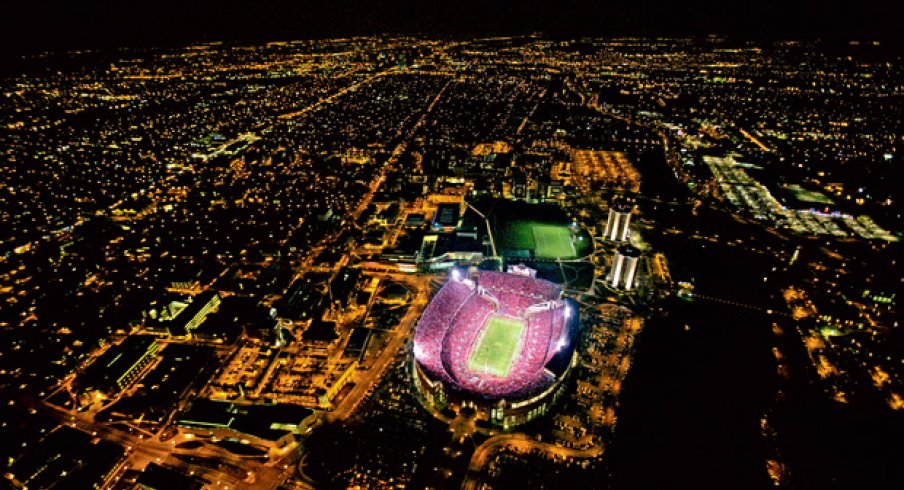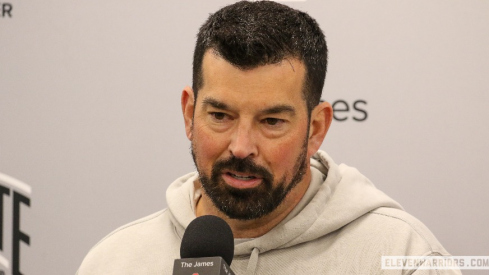It was announced Tuesday Ohio State would play an unprecedented third night game at Ohio Stadium during the 2014 season. It’s more than 100 years in the making.
In 1892, two small Pennsylvania schools played the first night game. But it was an event 47 years later that would have a lasting impact on college football that still reverberates today.
Sept. 30, 1939 was a typical late summer day across much of the United States. In New York City, where a million things happen every minute, a college football game was played between Fordham and Waynesburg. What was different about this game than the thousands played before was it was televised.
NBC broadcast the game with one camera, as Bill Stern provided play-by-play and analysis. An estimated 1,000 TVs picked up the game. During a two-year period several firsts in sports broadcasting occurred, setting forth a path that dominates the current landscape.
There was a time when even premier programs only had one or two games televised throughout an entire season. Then it grew to a handful and eventually all 12. Even the New Mexico States, Bowling Greens and Florida Internationals of the sport can find games on the Internet if they aren’t already on TV.
“We’re recruiting all over the country,” former Ohio State head coach John Cooper said in the 1990s, “and it’s nice to be able to go in someone’s home and say, ‘You can turn on the TV and watch the Buckeyes six to eight times a year."
It’s an outdated statement all these years later. Attention has since turned to the number of night games the Buckeyes play. Ohio State’s first regular season game under the lights came in 1958 at USC. It would have two more regular-season night games and seven overall until 1985, when the Buckeyes and Pitt played in the first night game in Ohio Stadium history.
Nearly 30 years later, the Horseshoe has hosted 14 night games. The last season Ohio Stadium didn’t feature a night game was 2007, and the last time Ohio State didn’t have a single regular season game played after 5 p.m. was 1996.
Ohio State athletic director Gene Smith said three night games per season is the target, with at least two in Columbus. His primary concern is student-athlete welfare and being at a competitive disadvantage. Returning home at 3 a.m. presents several challenges.
“[We] always [want] more at home than away, but three at home is probably a good number, four works,” Smith told Eleven Warriors. “We do not totally control away games. If my colleague at the away school wants to do it, I would have a hard time denying [them].”
There’s a possibility in the near future that half of Ohio State’s season could be played at night. The Big Ten already broke the November barrier with the announcement of two night games.
“As much respect as I have for the traditionalist, I want that 18-year-old to walk out of the stadium saying, ‘Wow, I have to be there,’” Ohio State head coach Urban Meyer said last year. “I don’t want them to have to get up at four in the morning to drive to our games, so I think we’re going to push a little bit for that.”
That statement was made during Meyer’s effort to have more night games and fewer noon starts. Recruiting was the impetus of Meyer’s campaign. And it worked, as Ohio State played three night games, including two at home.
“I love tradition, but I love recruiting better,” Meyer said. “Recruiting is really important in the game of college football. Like, really important. Like, more important than anything else.”
For six years in the SEC, Meyer saw how vital game-day atmospheres were to recruits. In Year 1 at Ohio State, he got another glimpse into the night game hoopla. Games against Nebraska and at Penn State stoked Meyer’s belief on the importance of playing in the evening.
“Our Nebraska atmosphere was as good as I’ve ever been around. There were other atmospheres that were just OK. But we don’t have time to be OK. Every time you have an OK, you’re not being great,” Meyer said. “The electric atmosphere we experienced at Penn State, I don’t want to use the term SEC-ish, but that was as good as there is.”
The proliferation of night games ties back to television, ratings and money. Higher rated games in primetime mean networks can charge more money for advertising. The increased revenue streams have contributed to lavish facilities.
Fans who once were hesitant because Saturday routines were interrupted have embraced the late starts and safety concerns have been alleviated.
The Ohio States, Alabamas and LSUs don’t shy away from night games because they provide a boost in recruiting. National exposure and unique atmospheres have been selling points to high schoolers for decades. It’s also led to the soaring popularity of college football.
Fifty million people attended a game last season. Upwards of 735,000 will witness Ohio State’s seven home games in 2014 and 315,000 will sit under Ohio Stadium’s new permanent lights.
The Buckeyes played in eight regular-season night games over a 16-year period from 1975-90. From 1991-99, they played in nine. Since 2000, that number has ballooned to 31, including 16 in the past five years alone.
“At some point,” Smith said, “we lose the novelty.”


